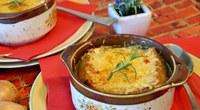Prairie Fare: Onions provide layers of flavor
(Click an image below to view a high-resolution image that can be downloaded)
“Mom, do you have a mandoline?” my son asked.
I wasn’t sure if he was asking about a mandolin stringed instrument or a mandoline food slicer.
He was in the kitchen. I figured he wanted to slice some vegetables thinly and not serenade our family.
He was in luck on the culinary side. I had a mandoline slicer in the cupboard. We do not have a mandolin musical instrument, but we have a ukulele, viola, banjo and guitar.
He found the slicing tool very helpful as he made burgers with all the fixings. He requested a mandoline slicer as a holiday gift.
By the way, mandoline slicers are very sharp, so be sure to use the slicing guard to avoid injury.
My older daughter, the onion expert, came to investigate. She loves to caramelize onions for soups and stews.
I deterred her from caramelizing onions for Tator Tot Hotdish at another meal. That would be kind of strange, I thought.
Maybe next time we will try a “Midwestern hot dish-French food fusion dish.” It might be good, or maybe, kind of weird.
Culinary experts recommend that we saute onions on low heat, as when caramelizing. The slow heating process helps prevent the development of a bitter flavor.
Onions are among the most popular vegetables used in cooking. They add flavor and nutrition without many calories. A medium onion (about ½ cup) has just 44 calories, no fat, 1 gram of protein and 2 grams of fiber, along with vitamin C and minerals such as phosphorus and potassium.
Researchers have linked onion consumption to reducing the risk for certain types of cancer and heart disease. Along with the beneficial sulfur compounds, onions are rich in the natural antioxidant, quercetin, that has health-promoting properties.
According to the National Onion Association, U.S. consumption of onions grew from about 12 pounds per person per year in 1982 and 20 pounds per person in 2018.
Onions can be sautéed, grilled, roasted, baked or eaten raw. Many people enjoy onion rings or onion blossoms. Try an air-fryer instead of a deep-fryer to reduce the fat content.
While several onion varieties are available, yellow onions are the most popular. They are typically sweet and caramelize well when making dishes such as French onion soup.
Red onions are second in popularity in the U.S., and they add color and a little “bite” to sandwiches. White onions often are used in light-colored foods, such as pasta salad, white sauces and potato salad.
Besides being tasty additions to our recipes, onions are linked with some potential health benefits.
Sulfur compounds are responsible for onion’s flavor and their tendency to make our eyes water. If onions make you cry, consider refrigerating them for about 30 minutes before slicing them. Leave the root end intact because that is where most of the sulfur compounds occur.
My hands always carry an aroma of onions after I chop them. Rubbing your hands with lemon juice can help remove the onion scent, unless you like it, of course.
When purchasing onions, look for onions that are unblemished and heavy for their size. Store them in a cool, dry place with air circulation.
You can prepare onions ahead of time to save time. After peeling or chopping them, refrigerate them for up to a week. You also can freeze prepared onions with or without a blanching (heating in boiling water or steam). Blanching vegetables generally results in a higher-quality product. See “Freezing Vegetables” from NDSU Extension for details.
Here’s a chance to practice cutting and caramelizing onions. This warm soup is tasty for cold winter weather.
French Onion Soup
1 pound yellow onions, sliced into ¼-inch half circles
2 tablespoons unsalted butter
½ tablespoons all-purpose flour
¼ cup apple cider
3 cups beef stock
Pinch dried thyme
Salt and freshly ground black pepper to taste
Small French baguette, sliced crosswise into 1/2-inch pieces
4 ounces Swiss cheese, grated on the large holes of a box grater
Melt butter in a heavy pot on medium-low heat. Add onions. Spread them out in as thin a layer as possible. Cook, stirring occasionally, until the onions are golden brown, beginning to caramelize, about 1 hour. Sprinkle flour over onions, and stir to coat. Add cider, stock, and thyme, and bring to a simmer. Cook partially covered for about 30 minutes, to allow the flavors to combine. Season with salt and pepper to taste. Ladle soup into oven-safe serving bowls and place one small slice of bread on top of each. Layer each slice of bread with ¼ cup grated cheese. Place bowls on a cookie sheet and broil in the preheated oven until cheese bubbles and browns slightly.
Makes six servings. Each serving has 200 calories, 8 grams (g) fat, 10 g protein, 24 g carbohydrate, 1 g fiber, 310 milligrams sodium.
(Julie Garden-Robinson, Ph.D., R.D., L.R.D., is a North Dakota State University Extension food and nutrition specialist and professor in the Department of Health, Nutrition and Exercise Sciences.)
NDSU Agriculture Communication – Jan. 10, 2024
Source: Julie Garden-Robinson, 701-231-7187, julie.garden-robinson@ndsu.edu
Editor: Elizabeth Cronin, 701-231-7881, elizabeth.cronin@ndsu.edu




